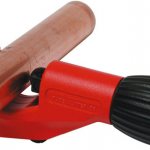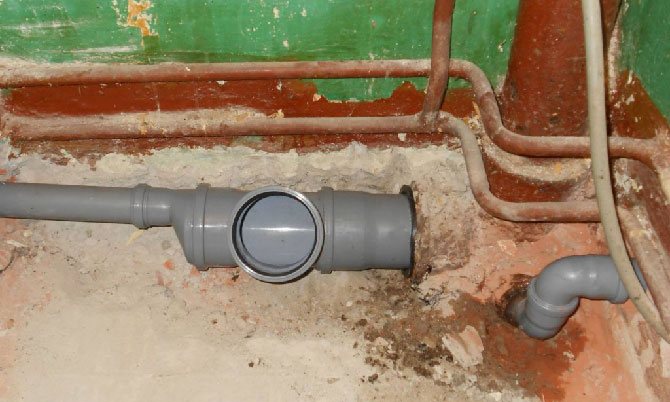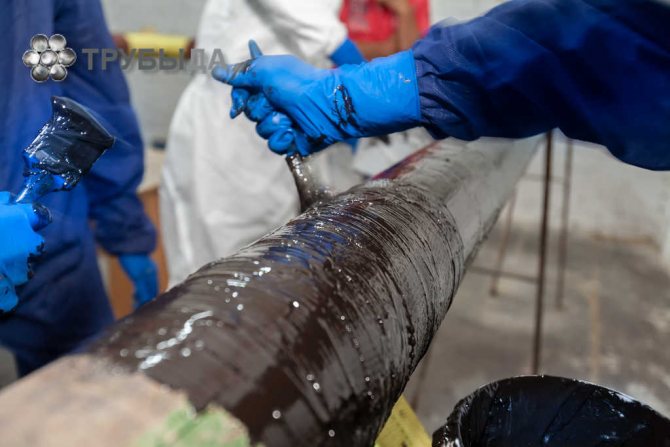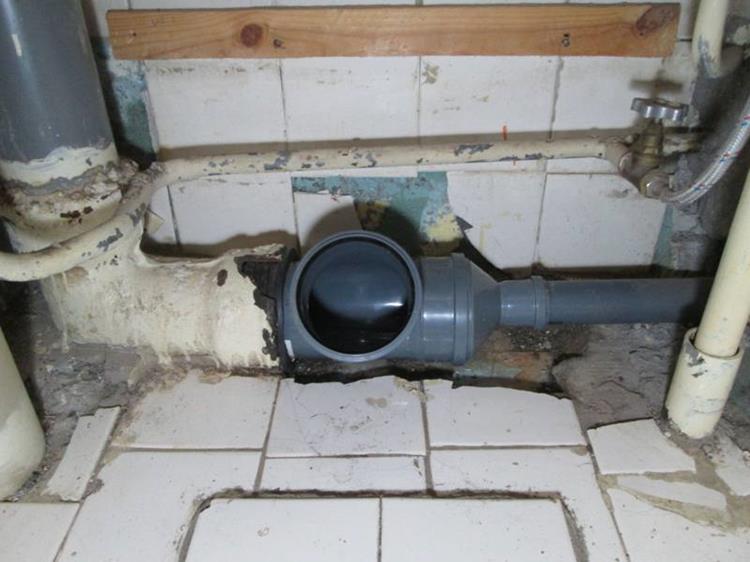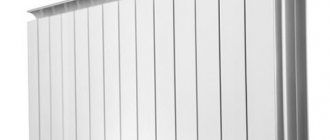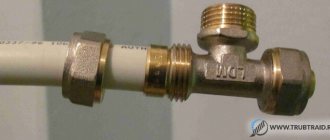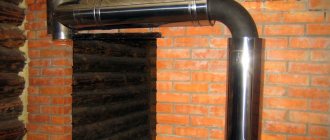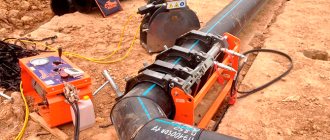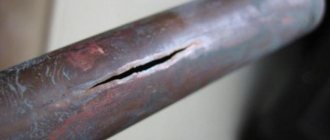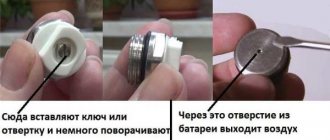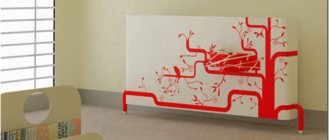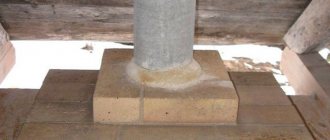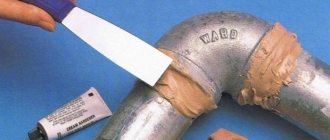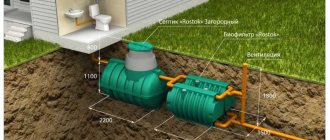Replacing cast iron sewer pipes time to dismantle
First stage. Using a pipe cutter, a vertical pipe is cut, if such a tool is not available, you can use a grinder. The cuts are made at a slight slope in relation to each other and at a distance of 10-15 cm. The cuts should converge closer to the wall, but the pipe itself should remain ¾ uncut. This is necessary so that the upper part of the riser does not bend. Then a wedge is hammered on both sides, after which it is necessary to break out the piece that was carefully cut out as possible. Be careful not to end up in the drain.
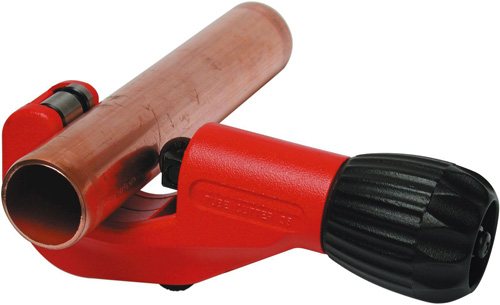
We cut the pipe with a pipe cutter
Replacing cast-iron sewer pipes with plastic ones is the second stage. The top edge of the pipe is cut at a predetermined height. To connect the plastic to the rest of the cast iron, it was easier to leave a piece of pipe. Its height must be equal to the size of the connector. It is recommended to mark the cutting line before cutting so that the edge is straight. After the pipe has been cut, a blow must be made towards the wall, which will provoke cracking.
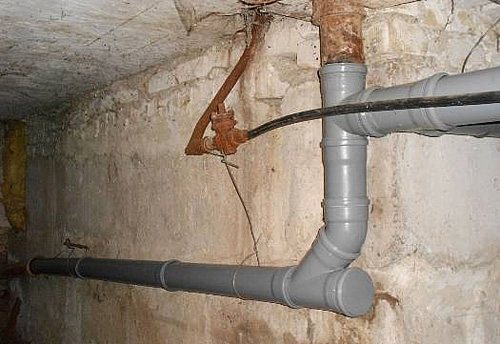

This is how a plastic pipe is connected to a cast iron
The third stage of dismantling consists in gently rocking the bottom of the remaining pipe, it is very important not to damage the lower bell. If it lends itself to rolling, then you can proceed to the extraction of such components as couplings, revisions, compensating pipes
Dismantling the old pipe
Dismantle the cast iron pipeline very carefully in order to prevent the appearance of chips or cracks.
We recommend that you familiarize yourself with: How to make a chimney box on the roof?
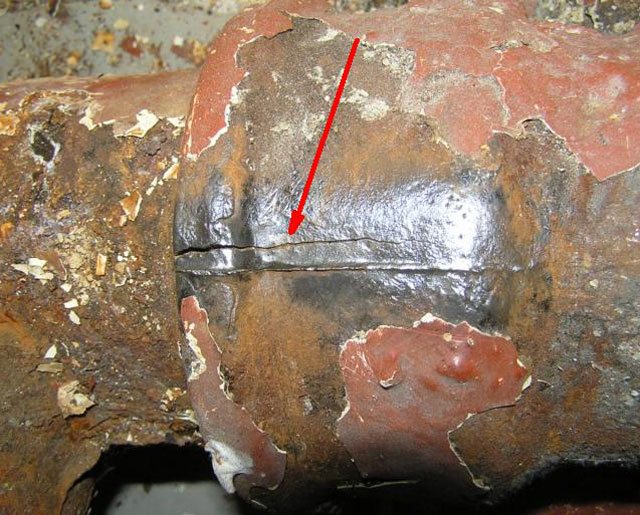

Joints have often been sealed with cement and tow, so it can take a lot of effort to loosen the joints.
It is necessary to disconnect the pipes by scrolling, and in no case by swinging. If you are not sure that the socket of the cast-iron pipe can be released without damage, it is better to carefully cut it off with a grinder.
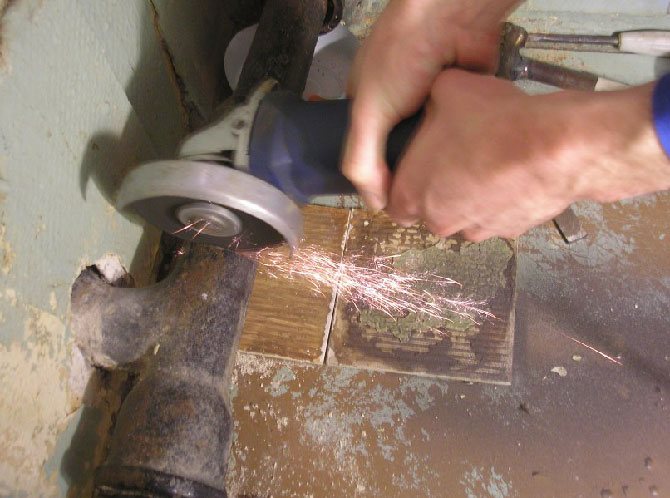

It is important! Do not try to break off a notched cast iron pipe. Most likely, the break will turn out to be uneven and you will have to cut it again. It is better to work with the grinder a little longer, and cut the cast-iron product completely.
Dismantling the cross when the joint is sealed with gray
The connecting piece itself is not sheared, but its 100 mm diameter extension must be removed. Now you can work with a blowtorch in the pipe, providing the necessary heating of the structure. On top of the product, an asbestos or metal shield is required to adjust the draft in the riser.
In the case when there are holes at the bottom near the socket, for example, obtained during the installation of water pipes, through them hot sulfur can penetrate into the plumbing unit of the neighbor from below. To prevent this from happening, the holes must be covered with plaster or cement. Mineral wool can be used to repair small crevices. The riser itself is sealed with a lump of fire-resistant materials to avoid the ingress of molten sulfur.
Warming up is carried out evenly, only the angle of inclination and the direction of movement of the fire change. This process must be controlled, otherwise the bell may crack, as evidenced by the powerful cotton. However, this rarely happens. Poor quality cast iron pipes usually burst.
One way or another, if the groove clearance allows, before starting work, it is recommended to clean out as much sulfur as possible using a drill with an extended drill or a hammer drill, but without a victorious tip.It should be borne in mind that heated liquid sulfur can flow inward or splash out. However, when it cools, it quickly takes on a solid state. It is better to put the frozen pieces some distance away from the burner flame.
It is not required to use a gas mask or special masks before the sulfur starts to burn. However, do not forget that from a strong fire, a liquid substance can boil and begin to spray out. To protect your face and eyes, it is recommended to wear special goggles when working with heating elements.
Periodically, you need to check the mobility of the cross by swinging or hitting with a hammer from different sides. As soon as you notice that a backlash appears, you must stop heating and start extracting the part using two adjustable wrenches. It is required to gently swing the element in different directions, then lift it up.
You need to be extremely careful, because the edges of the cross are quite fragile and can crumble when gripped with keys.
If there are droplets of burning sulfur on the surface of the pipeline connecting piece, it can be dipped into a metal bucket filled with cold liquid. Next, you need to clean the inside of the socket the remnants of sulfur and soot using an old chisel or a sharp penknife. Only after the funnel-shaped expansion has completely cooled down can you start installing the plastic riser.
We install a new system of sewer communications
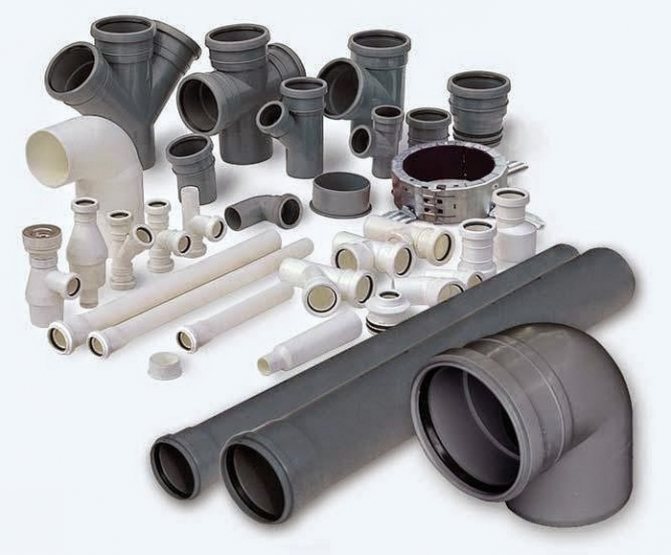

After dismantling the old system and cleaning the room from debris, you can start installing the new system. At the initial stage, an important condition is the choice of the type of connection. When installing plastic products, we use sockets with a sealing rubber. If other materials are used in the sewage system (ceramics, steel, cast iron), then an additional seal is created using a cement solution.
Advantages of cast iron sewage systems and applications
- Install the cuffs in the riser outlet;
- We insert the pipe into the cuff, you need to check the correctness of the fitting of the pipe;
- We determine the required length of the product, cut off the excess with the help of the grinder. It is recommended to clean the edge;
- We install the next pipe in a tee (adapter), the sections must be passed through with a high-quality sealant;
- After installing the pipes, according to the instructions, we connect all the necessary plumbing devices;
- Checking the quality of the work done. Water leaks through the connections are not allowed;
- We put things in order, we hide new communications to create a specious appearance of the room.
Advice: it will not be difficult to hide sewer communications. Use plastic or plasterboard panels, of which there is a very wide variety now in hardware stores. In addition, special blinds or ceramic tiles will help to hide communications, but if it is necessary to dismantle the system, you will have to disassemble the room to the ground.
When water pipes need to be replaced
After a certain period, all property owners have to replace the water supply and sewerage system. Over the years, a deposit forms inside the cast-iron pipes, which not only significantly impairs the permeability of the system, but also has an unpleasant odor. It will be simply impossible to do with simple cleaning. In addition, cast iron itself is a brittle metal, therefore, if the system is used incorrectly, cracks can form. Replacing the sewerage system in Moscow and other regions with a plastic service, which is quite expensive at a cost, while the process takes place in one sequence. The only thing that may differ is the prices for plumbing services and the quality of the work done. If you have any problems with the operation of the old system, it is better to immediately contact the professionals and change the long-worn water pipes.At the same time, the prices for replacing sewer pipes in an apartment can be radically different.
We determine the material for a new system of sewer communications
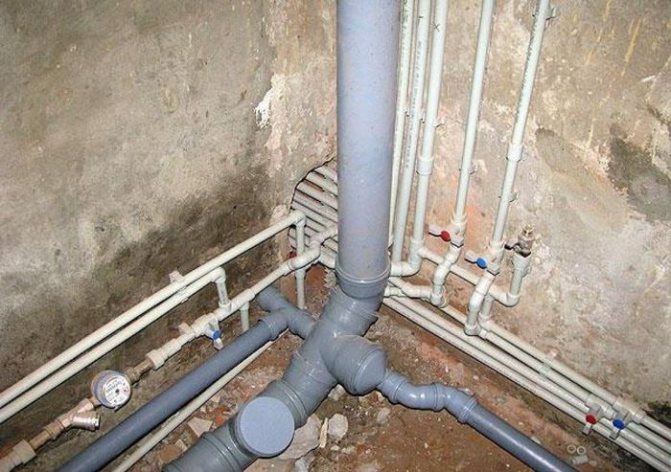

The entire operation of the system is based on the choice of materials used. The operational period of communications depends on this. Since the use of cast iron pipes is actually and morally outdated, the most common replacement is to replace cast iron pipes with plastic ones.
- Ceramic. The most expensive type of material, not available to everyone. The direct advantages of using ceramics include resistance to various kinds of chemicals. Installed, as a rule, in cost-effective industries that often use aggressive cleaning agents. They can be used when blocking sewers.
- Metallic. For the manufacture of metal pipes, cast iron and steel are used. Steel pipes are widely used in industrial premises. Due to their impressive weight and high corrosion rate, steel pipes are rarely installed as sewers in a private or apartment building. Cast iron - more resistant to corrosion, but also more expensive metal. The installation of cast iron pipes will cause a lot of inconvenience due to the large weight. Several decades ago, the use of cast iron pipes as sewer communications was ubiquitous. Today, the leading role is given to modern polymer alloys. They can be used when blocking sewers.
- Polymeric. The most sold, convenient and practical material in modern hardware stores. They can be used when blocking sewers. The advantages of polymer pipes include: high reliability, durability and ease of maintenance. This is achieved due to the smoothness of the inner walls of the pipe, due to which the accumulation of blockages is practically impossible. Such pipes are lightweight, so installation is easy to carry out alone. Also, such pipes are flexible, which is an important aspect when drawing up a plan for the proposed work and self-transportation of pipes. Among the significant disadvantages, only one stands out - insecurity against aggressive chemical solutions.
Also, polymer products can emit harmful substances into the atmosphere if they are heated to high temperatures. In general, the use of such pipes as sewer communications is the best solution for owners of private and apartment buildings.
Chasing
This method has been used for a long time. It is used when installing a cast iron pipeline. In this case, rubber seals are not used. The joints of the communication sections are sealed with tow (linen winding). For hardening, cement mortar is used. This method is used when the leakage between the walls of cast iron and plastic pipes is 3-5 mm. Instructions for the installation of communications using the stamping method:
- Plumbing paste is applied to the plastic pipe, tow is wound on top. The caulking depth is 2/3 of the socket length.
- The product is brought into the cast-iron pipeline until it stops.
- Tamp the tow using a narrow spatula, screwdriver.
- The remaining 1/3 of the socket is filled with polymer cement mortar. At home, it is prepared from cement, water and PVA glue.
The advantage of this method is a high degree of reliability. If the rubber adapter has been in operation for 8-10 years, then thanks to the stamping method, the pipe joint will last much longer. It also has disadvantages. So, they note the need to wait 1-2 days until the cement slurry hardens. The pipeline must not be used during this period. This will lead to deformation of the seam joint, which in the future will cause the destruction of the polymer-cement layer, and the appearance of a leak.
Sealing cracks or holes
Various materials and technologies are used to eliminate defects. The hole in the sewer can be closed using two universal fixing couplings UR-01. Their inner diameter must match the outer dimensions of the pipe.
The use of couplings does not require special tools:
- with the help of a grinder, a part of the pipe is cut out where a crack or hole has appeared;
- rust and dirt are removed from the ends of the pipes to be connected, where the couplings will be located;
- the distance to the middle of the coupling is measured;
- marks are made at the ends of the pipes for the indicated length;
- 2 couplings are wound on both ends of the pipe;
- a new piece of pipe is inserted (must have the same dimensions);
- the couplings move to the new pipe (their ends are located at the level of the marks made);
- using a wrench, the bolts are tightened on the couplings.
You can also plug the hole using a simple rubber sleeve with a seal. In this case, the joints must be covered with cement mortar, followed by paint application.
In such a process, how to repair a crack in a cast-iron sewer pipe, it is not recommended to use improvised means. Chewing gum, plasticine, glue, and other household products will fix the problem only for a short time. It is impossible to correct the situation by driving a wooden (plastic) chopik into the hole. This will cause further damage to the system.
When carrying out repair work, it is forbidden to remove the growths on the pipe, as this will lead to the appearance of a new leak. A large number of rusty growths indicates that in the near future it is necessary to completely change this section of the sewage system.
How to remove the lower parts of an old pipe when it is anchored with concrete in the floor and the joint is not treated with sulfur
The lower sections of the risers are usually made from component parts. They can include a coupling, an expansion pipe, and more. The first thing to do is check all joints for strength. Why, shake the pipe in the upper part, only very carefully so as not to harm the lower bell
Luckily, if it loosens a little, carefully remove all swinging parts. When the cross is even slightly loose at the joint, remove it using a nail pull
In the case when the cross is firmly fixed, you will first need to clean the joint deeper. If its clearance allows, then you can use a hammer drill with a narrow drill. Do not use a victorious drill. The mortar filling the joint is crumbled around the perimeter and removed with a chisel.
It is bad when there is practically no seam, and the cross is fixed firmly. Here you can try to clean the seam with a metal file. But, if these manipulations do not help, and you confidently wish to replace the crosspiece, then you will have to cut it 2-3 centimeters higher than the socket. The opening of the riser must be covered with a rag and fixed with a rope, this is done so that the scraps of cast iron do not fall into it. Then, using a grinder without protection, carefully cut the remainder of the pipe from the socket. At the same time, do not spoil the socket itself, which remains in the overlap. Use a special wedge to remove the remaining pipe fragments from the socket.
Replacement
It seems that a kitchen or sewage system mounted under the bathroom - a 50-50-50 tee through which drains from the bath or washbasin are drained - will not require any special skills to replace. Let's focus on how to replace the tee in the riser with your own hands.
We will need:
- The tee itself.
- Compensating pipe of the same diameter.
- Rubber collar - an adapter from a cast iron socket to a plastic pipe.
Raising and fixing the riser
You should start with a secure fit.
Otherwise, its subsidence after dismantling a part of the riser will lead to a leak from the ceiling or the collapse of the seal of the mounting hole.
- We cut off the water on the riser and warn the neighbors about the upcoming work.
- We remove the toilet and disconnect the comb (intra-apartment sewage system).
The photo shows the dismantling of the comb and the drain to the toilet.
- At a height of 1-1.5 m from the floor, we drill a hole in the wall behind the riser, as close to it as possible, with a drill with a diameter of 9.5 mm.
- We drive into it a piece of 10 mm smooth reinforcement.
- We tighten the riser with a thick wire a couple of centimeters below the reinforcement. The improvised clamp should not slip along the pipe.
- We put another similar clamp directly above the tee and, using a lever (scrap or pipe), lift the pipe by this clamp until it stops.
- We securely pull the upper clamp to the armature.
Dismantling
- With a chisel or perforator, we beat off the concrete embedding, freeing the tee and the socket under it.
Caution: pieces of concrete falling into the riser may become.
- Using a screwdriver, using a light hammer, remove the cement seal and, if possible, the cable from the tee socket.
- We cut the riser at a distance slightly greater than the length of the compensating pipe, from the socket under the tee. Make another cut 10 cm lower and remove the pipe piece.
- Turning the tee manually or with a gas wrench, remove it and clean the socket under it.
Installation
What does the actual replacement of a cast-iron sewer tee look like with a plastic one?
- The riser above the cut to the length of the expansion joint is cleaned of paint and debris.
- A clamp is installed directly under the cut - ordinary, plastic, from a store. He will have to keep the compensator from shifting.
- The compensating pipe is pulled over the cleaned pipe section. You can use regular or liquid soap as a lubricant.
- The tee is inserted into the socket of the riser by means of a rubber sleeve.
The cast iron tee is one of the main elements of the sewerage system.
It is an adapter that connects three pipes, by the way, one of them has a smaller diameter than the others.
This device is installed in those places where the pipeline acquires several directions.
Many people ask the question, is it possible to replace the cast-iron sewer tee? Practice shows that this can be done, but it is quite difficult with your own hands. Firstly, the technical process itself is rather complicated, and secondly, this type of repair of sewer pipes will require an expensive tool. Well, in general, it is quite possible to replace this part of the system, because it is not cast together with the pipe.
It looks like a cast iron tee
Replacing the tee with a grinder
What tools and materials will be required
Replacing a cast-iron sewage system begins with the fact that you decide on which pipes you are replacing. The most practical and affordable material is plastic. It not only looks good, but is a completely reliable alternative to cast iron products. The material has such advantages as low resistance to flow and thus a low risk of clogging. Also, the small weight of the elements is noted, which facilitates the installation process.
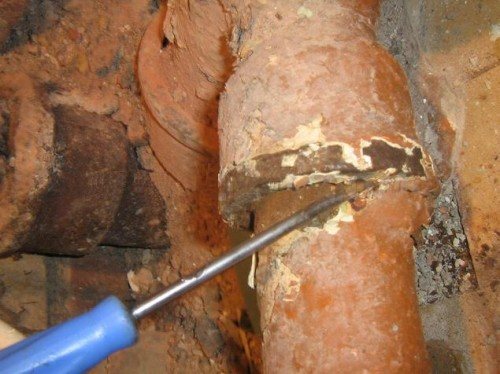

Plastic pipes for replacing the sewer
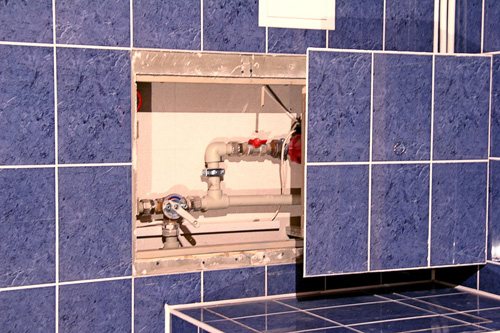

This is what an inspection hatch looks like
Required tool:
- the most important is the Bulgarian;
- gas-burner;
- hammer and chisel;
- level and tape measure;
- brand, plumb line, goggles, respirator.
Don't forget about sealants, grout and liquid soap on hand.
Dismantling
Work will start from the riser. The tube is cut at a distance of about 0.6 meters from the floor and 0.1 meters from the ceiling. The cut is not made continuous, but it is divided into two, with a narrow jumper. Later, it is broken with a hammer, and the cut pipe is removed. It is very difficult to accomplish this task alone.It is necessary for one worker to break the lintel and the other to hold the pipe
These manipulations are performed carefully. Otherwise, you can harm the riser section hidden in the ceiling.
This is not a problem when replacing the structure along the entire line. Disassembling the riser is the most time consuming part of the case. All other components of the sewage system are removed much easier and faster.
Piping selection and tools required
In old houses, all pipes were installed from cast iron, including sewer pipes. Of course, this is a very durable and reliable material, but it also has its own shelf life. Therefore, sooner or later, the time comes when it needs to be replaced.
Modern risers are made of an even more durable material, which is also lightweight and outwardly more aesthetic. Masters recommend switching to this more practical material. Steel or galvanized pipes will need to be replaced again after ten to twenty years. But if you make a replacement for polypropylene or polyvinyl chloride, then their operation is guaranteed for up to thirty to fifty years. And often it stretches for an even longer period.
And if, along with the replacement, you also take care of good ventilation, which can be purchased complete with pipes, then you can simply forget about sewer odors.
Since it is necessary to replace the cast-iron sewage system with a plastic one in a multi-storey building, the water is preliminarily shut off. Therefore, the work is done as quickly as possible.
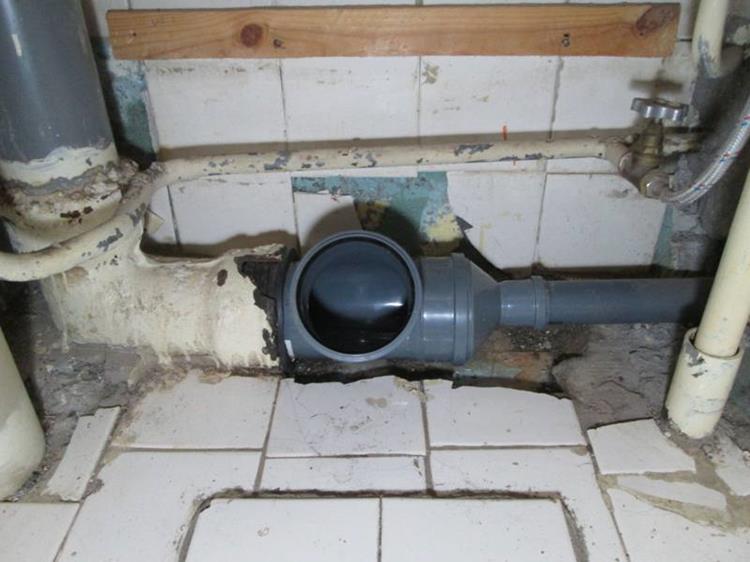

Also, neighbors from above are warned not to use the restroom and water, otherwise everything will go to your apartment, and the neighbors below will be flooded.
To dismantle a sewer riser, the following tools are required:
- Bulgarian;
- nail puller;
- a large screwdriver to remove small items from the system;
- chisel;
- puncher;
- a hammer;
- grinder;
- film to cover the pipe hole;
- an apron, gloves and glasses for personal protection.
Dismantling the old sewage system
Having decided on an independent replacement of the riser, it is best to agree with the neighbors so that, if necessary, they can provide access to the apartments. However, in most cases, the replacement takes place exclusively in your apartment between the floor and the ceiling.
The step-by-step instructions for removing the riser are as follows:
- A distance of ten centimeters from the ceiling surface and eighty from the tee is calculated. Two cuts are made with a grinder. The depth should be half the pipe diameter.
- A chisel is applied to the upper cut and beaten with a hammer. Then the same manipulation is repeated below. The blows must be applied with enough force to split the pipe so that the middle section is removed.
- The pipe from the ceiling is covered with polyethylene foil.
- When disassembling the lower part, which consists of a tee and other fittings, arm yourself with a nailer or crowbar to loosen the fasteners. Then remove the fitting. But, in general, this requires additional work with a hammer drill. With it, the cement on the fasteners is removed.
- With a chisel or a screwdriver, chip off the cement, and then remove the tee. If it did not work out, the fitting is cut off with a grinder, retreating up to three centimeters from the socket.
- In the remaining places, remove all dirt and clean the cast iron with a grinder.
Installation of pipes
After removing the old pipeline, you need to immediately install a new one so as not to cause unnecessary inconvenience to neighbors. But they start the process, like the previous one, with checking all the tools necessary for this.
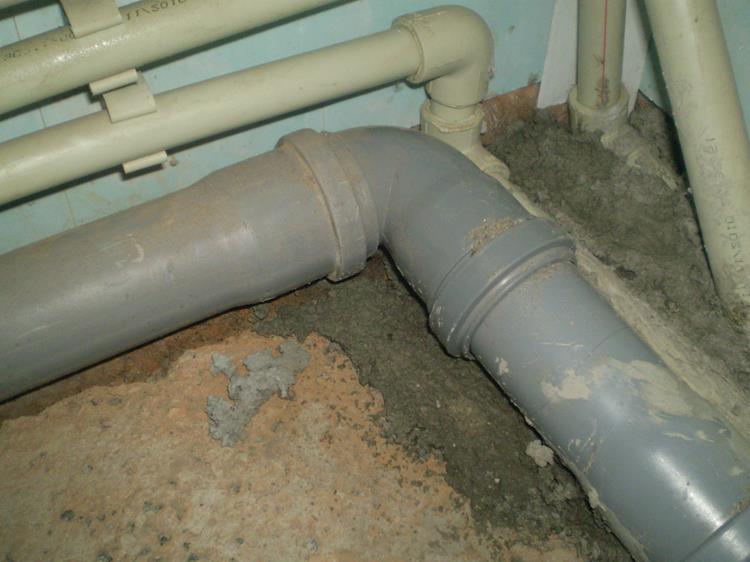

Installation requires the following equipment:
- pipes with a diameter of one hundred and ten centimeters;
- outlet tee made of the same material as the riser;
- rubber grommets to secure fittings between protruding cast iron stubs and plastic pipe;
- branch pipe for transition from cast iron to plastic and vice versa;
- pipe mountings;
- soap used to facilitate entry into the mounts, that is, a kind of lubricant;
- vertical building level.
Installation takes place in the reverse order compared to dismantling:
- The rubber sleeves are inserted into the pipe cut.
- Attach the adapter at the top and the tee at the bottom. All parts must be fastened as tightly as possible to ensure maximum tightness. With the free movement of the tee, the connection is sealed using silicone sealant or flax winding.
- The plastic riser is secured with clamps. If the ceiling height is standard, then they usually manage with three pieces: for the top, bottom and middle. If it is high, then you need to purchase additional connections.
- The system is pre-assembled.
- A branch pipe must be lowered into the tee to connect the plastic and cast iron.
- Each fastener is lubricated with a silicone sealant and wait for it to solidify.
- Then turn on the water and check the pipe connections for leaks. If everything is in order, then this part of the work can be considered completed.
Installation of a new sewer riser
When replacing a sewer riser, assembly is carried out in the reverse order from bottom to top, already from plastic parts. First, clean and degrease all joints, both plastic-plastic and plastic-cast iron. On the sealant (although some suggest a thick soapy water or something else), press in the tee. After that, already without sealant, "for fitting", assemble the entire structure of pipes, couplings and a flange for revision (if it was provided structurally), and mark the places for fastening to the wall. Disassemble the pipe, plug the drain hole and first drill, and then install the clamps. Depending on the height of the ceilings and on the subsequent stitching of the pipe, there can be from two to four, there is simply no need for more.
Again, already on the sealant, assemble the entire structure and fix it with clamps. The drain can be used.
How do you see, replacement of a sewer riser not such a difficult task. After all, the difference in price, if you resort to the services of a plumber, and do everything yourself, even taking into account the rental of a puncher, will be strikingly different. And the time spent on this is only a couple of hours.
The advantages of plastic sewage
Sewerage with a cast-iron pipe becomes completely unusable after 40-50 years of use. It is optimal to replace it with practical polypropylene or PVC pipes. These materials have enough advantages:
- light weight compared to metal;
- smooth inner surface (reduces the risk of blockages, simplifies the cleaning process);
- plastic is not afraid of corrosion;
- no special equipment is required for installation.
The only drawback of plastic is a high noise level when water is drained or wind noise (in a private house). A soundproof box made of soundproof materials will help to solve this problem.
Features of the plastic elements of the system
It is believed that replacing cast-iron sewer pipes with plastic ones makes it possible to obtain a sewer system that is more stable in operation. On the whole, this opinion is correct. Positive qualities of plastic pipelines:
- light weight, no load on supporting structures;
- smooth surface, less risk of fatty deposits;
- simplicity, high speed of installation;
- durability;
- corrosion resistance;
- availability of a complete set of additional elements;
- the ability to change pipes with your own hands;
- attractive appearance.
Disadvantages of plastic elements:
- high noise level;
- relatively low strength;
- high coefficient of thermal expansion of the material.
The presence of flaws does not scare users. Replacing cast-iron sewers with plastic ones is becoming the norm. Only a few houses still have old pipes, which have not yet reached their turn.
Plastic elements are superior to alternative types in all respects.They are cheap, allow you to get any system configuration. Users consider the main advantage of the assembly speed, the presence of any components.
Preparing to replace the cast-iron sewer with a plastic one
Dismantling a cast-iron sewer with your own hands begins with the preparation of tools.
The work is done using:
- chisels;
- a hammer with a nozzle (rubber or wooden);
- puncher;
- chisels;
- 2 adjustable wrenches, knives, screwdrivers, crowbar, steel wedge for disassembling pipe parts;
- grinder, grinding disc and 3-4 pieces of 125 mm discs.
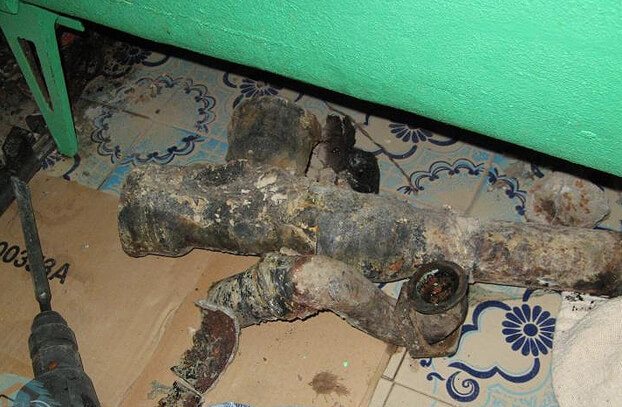

Before dismantling, it is determined how cast-iron parts (in particular crosses and tees) were connected to the shaped section, for which it is necessary to find the connection point - usually it is located higher than the level of the floor covering. If tiles are laid on the floor or there is a screed, then a perforator or chisel is required to search
You need to work with them carefully - you cannot damage the bell that remains in the overlap.
The connection between tees, crosses and pipes can be done in three ways:
- filled with gray;
- polymer-cement mixture;
- caulking with a solution. You can use cement-sand or cement.
Press fitting connection
In this case, a special adapter made of metal (steel) is used. On the one hand, there is a thread for connecting to a cast iron pipe, on the other, a socket for connecting a plastic pipeline. For work, you will need an angle grinder, a thread cutter. Installation instructions:
- It is necessary to prepare a cast iron pipe. A cut is made with a grinder. If a clutch is installed in this area, unscrew it. The threaded connection is now complete. Otherwise, the thread must be done independently, for which a thread cutter is used.
- A sealing tape is applied to the prepared cut. As an alternative, tow can be used.
- To strengthen the threaded connection, a sealant is applied from above.
- Install the press fitting. However, it should be screwed onto the pipe manually. In this case, you cannot use an adjustable wrench, because the fitting may burst.
- On the other side, a plastic pipe with a crimp collar is connected.
In order for this section of the pipeline to be operated without interruptions, it must be remembered that a fitting made of polyvinyl chloride cannot be installed on a metal base.
Pipe replacement materials
The number and diameter of plastic pipes, fasteners, connection parts depends on the wiring diagram. If the products will simply be put in place of the old ones, it is easy to count them. On a plastic riser, it is imperative to make an inspection hatch. For work, you will need some shaped elements to connect different diameters of products. These are tees, crosses, rubber cuffs, plastic adapters, seals. Of the tools you need:
- grinder with discs;
- nail puller;
- blowtorch (not always needed);
- a hammer;
- roulette;
- respirator and goggles;
- chisel;
- marker;
- puncher;
- building level;
- plumb line;
- ladder;
- pipe with a diameter of 110 mm.
The plastic product must be checked against the markings applied to it. It must be designed for sewer works
This is important because sewage is highly aggressive. In addition to improvised tools, you will need a silicone sealant
It will come in handy when sealing riser joints. Liquid soap and cement may be required.
Correct embossing of the fan tee. Dismantling of the cast iron sewage system. Switching from cast iron to plastic.
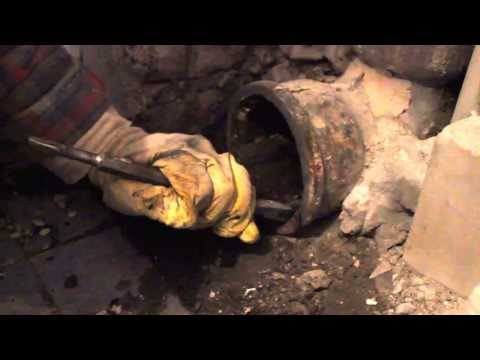

Watch this video on YouTube
Required tools and accessories
In order for the working process to go through quickly and efficiently, you must have the following tools at hand:
| Grinder with discs for metal | Without it, it is impossible to dismantle the old cast-iron element.An option with any blade diameter will work, it is important that you have several replacement cutting elements, as they wear out rather quickly. It is not necessary to buy equipment just to replace the riser, you can borrow it from friends or rent it for one day |
| Hammer, chisel, pry bar | This hand tool will be needed both for removing the old pipe and for removing the tee. It is better if you take a heavy hammer with a mass of about a kilogram, they can be applied very strong blows, which is very important for quick dismantling. |
| Perforator | With its help, you can break the solution, which usually fixes a cast-iron tee. Also, you cannot do without a punch if you need to fix the clamps on a concrete or brick wall, in this case you need a drill, the diameter of which should be equal to the size of the dowels |
| Other fixtures | Of course, this is not a complete list; it can vary depending on the specifics of the work and many other factors. It should be noted that it is imperative to have on hand a tape measure and a marker for marking, as well as a grinding disc for the grinder, which will clean the ends of the cast-iron riser |
Important! In addition to the working tool, do not forget about the need for protective equipment: you will need overalls, gloves, and protective goggles, since a lot of sparks are formed during cutting.
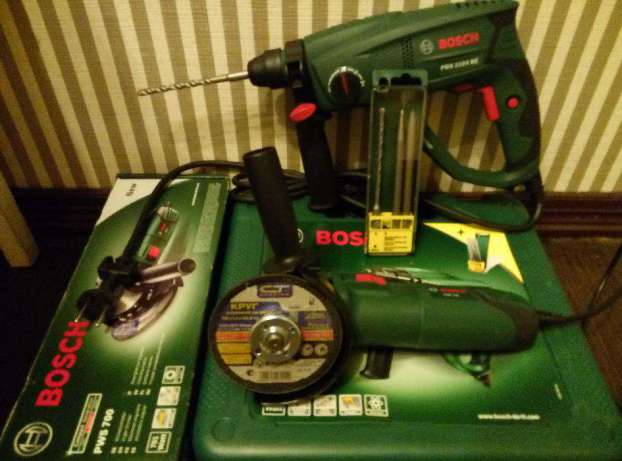

Without a grinder and a perforator, replacing the sewer is hardly possible
Noise isolation and causes
Of course, PVC and polypropylene pipes are much better than cast iron pipes. They will last longer, have an aesthetic appearance and are much cheaper. However, they have one significant drawback. This is noise. At first, even experienced specialists did not know how to deal with this. But today, as soon as the pipes are installed, they begin to deal with noise and sound insulation. Doing this is not at all difficult on your own. Therefore, do not be afraid! Having done this work, you will forget what the noise from the pipe is.
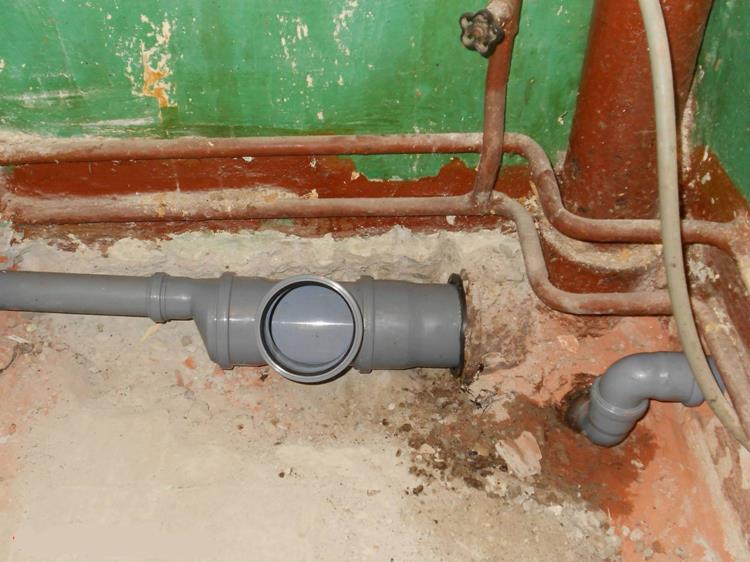

installation of a plastic pipe with a non-return valve and connection to a cast-iron pipe of a riser
There is no one way to achieve soundproofing effect yet. Therefore, they are used different, depending on the design, acoustic features and the availability of certain materials.
Why do cast iron pipes make no sound, while modern plastic pipes are so noisy? After conducting special studies, several reasons for extraneous sounds from the riser were revealed. Among them are:
- percussive sounds occur when the content beats against the walls of the pipes, making a noise;
- atmospheric phenomena occur when the howling of the wind, the sound of rain, or even more hail;
- resonant manifestations appear when extraneous noise is transmitted;
- vibrational sounds are transmitted from the entire structure, underground traffic, and so on.
The pipe itself, due to its shape, presupposes the possibility of perception and transmission of the different nature of sounds. But the material from which it is made is also important. Those cast iron risers that still stand in old buildings do not make noise for this very reason. After all, it is not completely metal. It is an alloy that consists of different grains that differ in composition and properties. Thanks to this, sound absorption is ensured, since the grains rub against each other and reduce vibration.
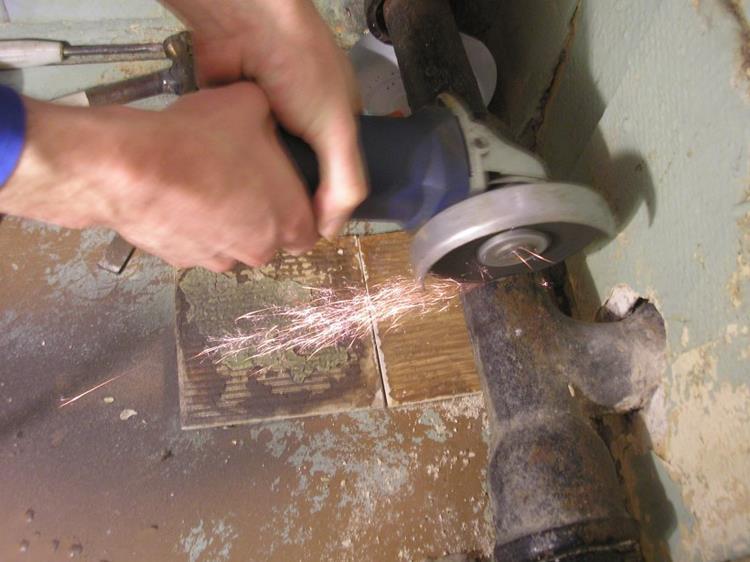

trimming old cast iron pipe
In addition, such pipes are covered with plaque from the inside, which in itself plays the role of an excellent sound insulator, despite the fact that the movement of wastewater slows down.
Methods for connecting plastic and cast iron pipelines
The choice of one or another method of connection is due, first of all, to the fact whether it was possible to keep the bell of the cast-iron pipe intact, or it was cut off. The further choice of the installation method is determined based on personal preferences and the availability of the necessary materials and tools.
Application of rubber pad
This method of connection is justified in situations where the socket of the cast-iron pipe was released and kept in good condition. The approximate course of action can be described as follows:
- The socket is thoroughly cleaned of dirt and rust, after which it is dried, and on the inside it is coated with a layer of sealant.
- The outer surface of the adapter, in turn, is also coated with a sealing compound and inserted into the socket.
- Further, the end of the plastic pipe is inserted into the free end of the cuff until it stops.
- All joints are once again treated with a sealant.
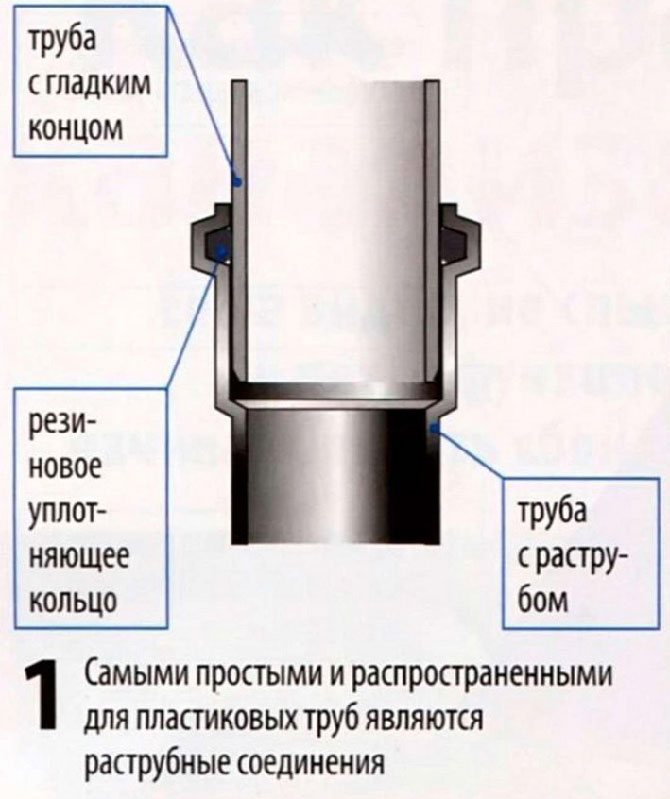

It turns out a completely reliable connection, which, if necessary, can be easily disassembled.
Using a plastic adapter with a rubber seal
This method is suitable in cases where the socket of the cast-iron pipe had to be cut off:
- The edge of the cut pipe should be as straight as possible.
- A rubber ring treated with a sealing compound, as well as a rubber cuff, are put on the edge of the cast-iron pipe.
- A plastic adapter is put on top, which in turn is also treated with a sealant.
- A piece of plastic pipe of the corresponding diameter is connected to the adapter.
We recommend that you familiarize yourself with: How to determine the required chimney height relative to the roof ridge?
Using a pressfitting
A press fitting in this case can be described as a special adapter equipped with a thread for attaching to the cast-iron part of the pipeline at one end, as well as a socket for mounting the plastic part of the pipeline at the other. The reliability of this type of connection is very high, but the installation method is also the most laborious:
- The end of the cast iron pipe is cut neatly. At the same time, the chamfer is removed.
- Further, the place of the cut is lubricated with grease (any machine oil), after which the thread is cut. The thread depth should not be more than 50 mm.
- Thread sealing is done by winding plumbing tape or tow. To enhance the tightness, an additional layer of silicone can be applied.
- The press fitting is carefully screwed onto the thread. Tightening wrenches are not recommended as they can easily damage the threads and inevitably lead to leaks. It is possible to tighten the element more tightly after the water has been supplied, if leaks are detected in this area.
- A plastic pipe with a ferrule is pushed onto the other end of the fitting. Using a special hand press, crimping is performed, which ensures excellent tightness.
Note! The use of a press fitting will additionally require taking into account a certain difference between the coefficients of thermal expansion for metal and plastic products. It is for this reason that experts do not advise winding PVC fittings onto cast iron.
Flax embossing
This method was almost the only one before the advent of modern silicone sealants, although many craftsmen still prefer it to everyone else:
- In the place of the supposed joint, a linen winding is wound in several layers at the end of the plastic pipe.
- The plastic is inserted all the way into the socket of the cast-iron pipe.
- Using a wide flat screwdriver or a narrow spatula, the reel is pushed as tightly as possible into the gap between the pipes to be connected. This stage of work is precisely called chasing.
- Further, the junction of cast iron with plastic is thoroughly coated several times with a special mixture, which contains cement, PVA glue and water.
- After 24 hours, the mixture completely solidifies and the ready-made pipeline can be used.
We recommend that you familiarize yourself with: Features of the use and installation of the HDPE sleeve under the flange
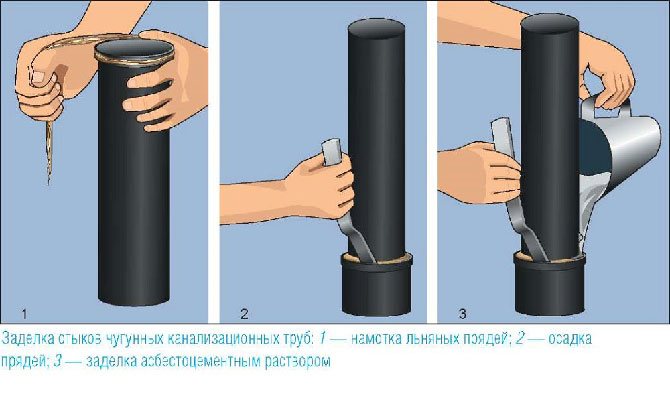

Silicone sealing
Least time consuming method.If the dimensions of the gap between the cast-iron socket and the plastic pipe inserted into it do not exceed 2 mm, simple sealing of the joint with sanitary silicone is allowed.
- The cast iron socket is thoroughly cleaned and dried (it is better to do this with a construction hair dryer).
- The end of the plastic pipe is wrapped with plumbing thread and placed into the socket to a depth of 8-10 mm.
- Silicone is fed into the slots in an amount sufficient to fill all the voids.
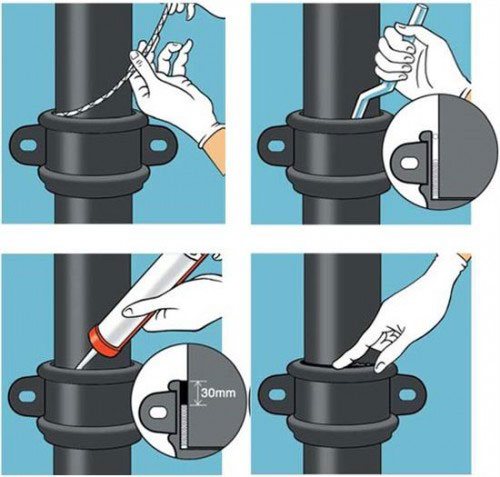

Special attention should be paid to the joint area at the bottom, trying to place the silicone as far as possible into the gap (it is convenient to use a special tool for this purpose, for example, a construction gun).
The procedure for complete drying of silicone, as a rule, takes 3-5 hours.
Flange connection
Perhaps one of the most difficult connection methods. For installation, you will need to purchase special connecting parts.
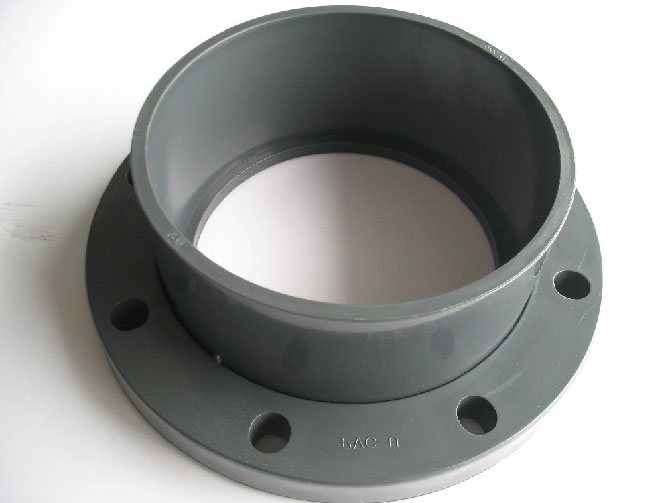

In addition, the use of welding equipment will be required, which will allow not every owner of a house or apartment to carry out the entire volume of work on their own.
The recommended sequence of actions is as follows:
- The cast iron pipe is cut and cleaned.
- A metal flange is welded to it.
- A special crimp sleeve is applied to the resulting structure.
- Further, a seal is placed between the flange parts, after which they are tightened with bolts.
It should be noted that flange connections are most often used for large (200 mm or more) pipe diameters.

